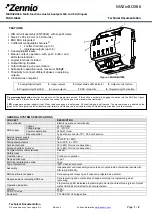QADC64E Legacy Mode Operation
MPC561/MPC563 Reference Manual, Rev. 1.2
Freescale Semiconductor
13-51
13.5.6
Periodic / Interval Timer
The on-chip periodic/interval timer can be used to generate trigger events at a programmable interval,
initiating execution of queue 1 and/or queue 2. The periodic/interval timer stays reset under the following
conditions:
•
Both queue 1 and queue 2 are programmed to any mode which does not use the periodic/interval
timer
•
IMB3 system reset or the master reset is asserted
•
Stop mode is selected
•
Freeze mode is selected
NOTE
Interval timer single-scan mode does not use the periodic/interval timer
until the single-scan enable bit is set.
The following two conditions will cause a pulsed reset of the periodic/interval timer during use:
•
A queue 1 operating mode change to a mode which uses the periodic/interval timer, even if queue
2 is already using the timer
•
A queue 2 operating mode change to a mode which uses the periodic/interval timer, provided queue
1 is not in a mode which uses the periodic/interval timer
•
Roll over of the timer
During the low power stop mode, the periodic timer is held in reset. Since low power stop mode causes
QACR1 and QACR2 to be reset to zero, a valid periodic or interval timer mode must be written after stop
mode is exited to release the timer from reset.
When the IMB3 internal FREEZE line is asserted and a periodic or interval timer mode is selected, the
timer counter is reset after the conversion in progress completes. When the periodic or interval timer mode
has been enabled (the timer is counting), but a trigger event has not been issued, the freeze mode takes
effect immediately, and the timer is held in reset. When the internal FREEZE line is negated, the timer
counter starts counting from the beginning. Refer to
Section 13.5.7, “Configuration and Control Using the
,” for more information.
13.5.7
Configuration and Control Using the IMB3 Interface
The QADC64E module communicates with other microcontroller modules via the IMB3. The QADC64E
bus interface unit (BIU) coordinates IMB3 activity with internal QADC64E bus activity. This section
describes the operation of the BIU, IMB3 read/write accesses to QADC64E memory locations, module
configuration, and general-purpose I/O operation.
13.5.7.1
QADC64E Bus Interface Unit
The BIU is designed to act as a slave device on the IMB3. The BIU has the following functions:
•
Respond with the appropriate bus cycle termination
•
Supply IMB3 interface timing to all internal module signals
Summary of Contents for MPC561
Page 84: ...MPC561 MPC563 Reference Manual Rev 1 2 lxxxiv Freescale Semiconductor...
Page 144: ...Signal Descriptions MPC561 MPC563 Reference Manual Rev 1 2 2 46 Freescale Semiconductor...
Page 206: ...Central Processing Unit MPC561 MPC563 Reference Manual Rev 1 2 3 62 Freescale Semiconductor...
Page 302: ...Reset MPC561 MPC563 Reference Manual Rev 1 2 7 14 Freescale Semiconductor...
Page 854: ...Time Processor Unit 3 MPC561 MPC563 Reference Manual Rev 1 2 19 24 Freescale Semiconductor...
Page 968: ...Development Support MPC561 MPC563 Reference Manual Rev 1 2 23 54 Freescale Semiconductor...
Page 1144: ...Internal Memory Map MPC561 MPC563 Reference Manual Rev 1 2 B 34 Freescale Semiconductor...
Page 1212: ...TPU3 ROM Functions MPC561 MPC563 Reference Manual Rev 1 2 D 60 Freescale Semiconductor...
Page 1216: ...Memory Access Timing MPC561 MPC563 Reference Manual Rev 1 2 E 4 Freescale Semiconductor...


















